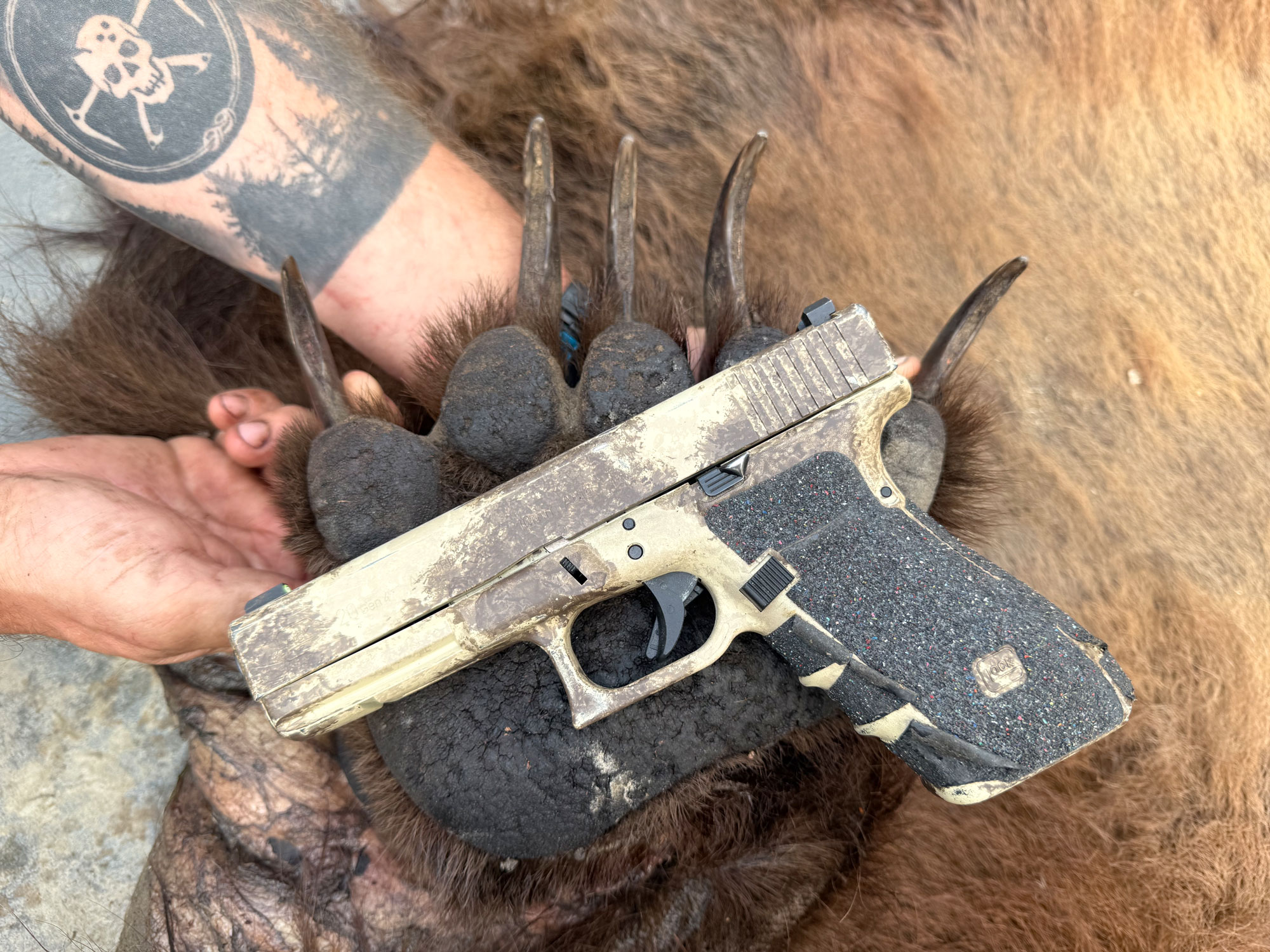The smell of death gets your attention, especially when you’re walking through thick alders and brush in grizzly bear country. That piercing odor usually means one thing: a bear kill is nearby.
Bear defense is a popular topic, and many hunters have imagined scenarios where they may have to fend off an aggressive bear with their handgun. Undoubtedly, clearing their meticulously-oiled leather holster in the nick of time to perfectly place a single cast .44 Magnum slug squarely on the bear’s head, sending him skidding to a final stop within spitting range of their chaw tobacco. Reality rarely lives up to romanticism, however, and surviving a real-life aggressive bear encounter has a lot more to do with basic, and sometimes mundane, principles.
A Close Scrape
On Saturday my good friend Brett TerBeek and his hunting partner Andy were scouting a remote river for promising moose hunting spots to hunt in September. They left their boat to hike about a mile to a high point to look over the surrounding areas for good calling locations.
As the pair was walking through thick alders and young birch trees, they caught a fleeting whiff of something dead. Brett and Andy remained alert, but kept walking forward. After proceeding about 100 yards, the foul stench hit them again. They froze and looked around. Sensing that they were near a kill, Andy drew his 10mm Glock G20, and Brett drew his own G20.
Andy pivoted left, looking past Brett, and said, “Bear, right there!”
TerBeek told me that as Andy said that, he turned and saw the huge grizzly’s head rise from the brush, only 10 yards away. The board locked onto them and laid its ears back as it sidestepped the moose carcass he had been on. He came lunging straight through the brush toward both men.
“Andy fired the first shot,” says Brett, “and I remember seeing a perfect sight picture in the center of the bear’s mass as I squeezed the trigger.”
Both Brett and Andy served as Green Berets for a decade before going to PA school together in the Army, and Brett credits his years of service using the 9mm Glock G19 for being able to fire rapid, controlled shots with the larger-but-similar 10mm Glock G20.

“This all happened so fast, it takes way longer to tell the story,” Brett says of the bear’s charge. In the open at a full run, an adult Grizzly can cover 10 yards in a second or two.
“He was crashing directly through the brush towards us and, afterward, branches were all broken and plowed over and we found at least two that our bullets struck. When he got to about five yards, he turned to his right to step into a more clear path towards us and we kept shooting. As he moved into that open lane, I knew I had at least one or two of the fifteen rounds left — I hadn’t been counting — and I needed to save those until he got right on top of us.”
Fortunately for the pair, the bear collapsed there, at 5 yards, and the adrenaline still pumped as the big bear’s chest heaved slowly.
Over in an Instant
“It was all over in a matter of a few seconds,” Brett told me the following day, as we stood looking at the massive skull and hide. (In Alaska, when a grizzly or other animal is killed out-of-season in self-defense, the incident must be reported. Alaska’s Wildlife Troopers met him at the boat launch to examine the bear and take the report. He was instructed to turn in the hide and skull the following day at the Department of Fish and Game, so I was lucky to get a look at it first.)
“If we had been using bear spray, I don’t think we would have been able to stop the boar before he got to us,” Brett says. Additionally, the tight brush would have likely caused them to be incapacitated by the spray, too.
The boar was truly a massive interior grizzly. We roughly measured the skull to be about 25 inches, length plus width, and the hide was close to 9 feet squared. I have killed eight interior grizzlies myself, and the largest — which tied for number six in Pope and Young at the time — measured 25 2/16 inches. Anything over 23 inches is a world-class bear, and it was significantly larger than my last grizzly, taken with a 6.5 CM.

The Boring Basics of Bear Defense
Both Brett and Andy were using the popular Glock G20, one of the most popular, and proven, backcountry defense pistols in recent years. They were shooting a mishmash of ammo, with Andy using Federal 200-grain Punch JHP ammo and Brett using a coffee-can mix of Buffalo Bore 180-grain JHP and hard-cast bullets.
The two men fired eight shots each — 16 shots total — in the short exchange, hitting the bear multiple times. They didn’t get an exact count because they spent the next few hours skinning the bear with a dull Leatherman and lugging the heavy hide and skull a mile back to the boat without a pack frame. Still, we were able to find one shot that hit a front paw. One shot hit the top of the bear’s head, appearing to penetrate into the neck. Another shot hit the bear straight in the mouth and broke some front teeth. There were about 10 additional shots that hit the chest and ribs for a total of 13 rounds that struck the bear.

What Really Matters for Bear Defense
In any self-defense encounter with a bear, luck and circumstance certainly factor into the outcome. But as for factors within their control, Brett simply credits carrying a pistol he’s familiar with — one that he can shoot well and has practiced with a lot. More importantly, he had that pistol at the ready on his chest, even when he wasn’t expecting an encounter. He said that he’d even considered leaving it at the boat for this hike, but had brought it along just in case.
Read Next: Best Bear Defense Handguns
“Being able to fire multiple quick, accurate shots is what stopped that bear,” he told me. In other words, he and his buddy stopped a charging grizzly thanks to their situational awareness, training, and reliance on shootable pistols that they wore at the ready.
Read the full article here



